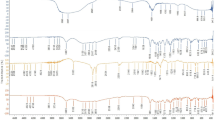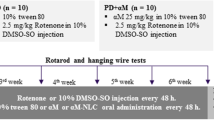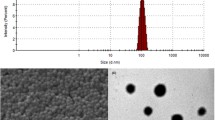Abstract
The present study investigated brain delivery system of vasoactive intestinal peptide (VIP) adsorbed on poly (butyl cyanoacrylate) nanoparticles coated with polysorbate 80 (P80-poly (butyl) cyanoacrylate (PBCA)-nanoparticles (NPs)) and the neuroprotective effects on the formulation in the model of 6-hydroxydopamine (6-OHDA)-induced Parkinsonian dysfunction in the human neuroblastoma cell line SH-SY5Y. Drug-loaded nanoparticles were prepared by emulsion polymerization method using VIP and PBCA and then stirring with polysorbate 80. The resulting nanoparticles possessed high entrapment efficiency and favorable stability against CaCl2 or fetal bovine serum (FBS)-induced aggregation. Use of fluorescein isothiocyanate (FITC)-conjugated polysorbate 80-PBCA nanoparticles in confocal microscopy revealed that nanoparticles are located inside, while the FITC solution could not penetrate into the cells. The blank nanoparticles showed no significant effects on cell viability, indicating that they had no role in protection; however, polysorbate 80-modified VIP-loading PBCA nanoparticles showed enhanced cell viability compared to free VIP in 6-OHDA-mimic cellular model of Parkinson’s disease. In addition, the nanoparticles strikingly increased the anti-apoptosis activity and restored the loss of mitochondrial membrane potential (MMP) significantly after the treatment of 6-OHDA. These results demonstrated that the activity of VIP was enhanced by polysorbate 80-PBCA nanoparticles compared to control solutions, suggesting that PBCA nanoparticles coated with polysorbate 80 could be an effective carrier system for VIP.







Similar content being viewed by others
References
Alyautdin R, Gothier D, Petrov V, Kharkevich D, Kreuter J (1995) Analgesic activity of the hexapeptide dalargin adsorbed on the surface of polysorbate 80-coated poly (butyl cyanoacrylate) nanoparticles. Eur J Pharm Biopharm 41(1):44–48
Ashok B, Rubinstein I, Tsueshita T, Onyuksel H (2004) Effects of peptide molecular mass and PEG chain length on the vasoreactivity of VIP and PACAP(1–38) in pegylated phospholipid micelles. Peptides 25(8):1253–1258. doi:10.1016/j.peptides.2004.05.013
Banerjee T, Mitra S, Kumar Singh A, Kumar Sharma R, Maitra A (2002) Preparation, characterization and biodistribution of ultrafine chitosan nanoparticles. Int J Pharm 243(1–2):93–105
Bickel U, Yoshikawa T, Landaw EM, Faull KF, Pardridge WM (1993) Pharmacologic effects in vivo in brain by vector-mediated peptide drug delivery. Proc Natl Acad Sci U S A 90(7):2618–2622
Blandini F, Mangiagalli A, Cosentino M, Marino F, Samuele A, Rasini E et al (2003) Peripheral markers of apoptosis in Parkinson’s disease: the effect of dopaminergic drugs. Ann N Y Acad Sci 1010:675–678
Bloom S, Iversen LL, Quik M (1978) Effect of vasoactive intestinal peptide (VIP) and other neuropeptides on cAMP accumulation in brain slices [proceedings]. Br J Pharmacol 62(3):435P
Blum D, Torch S, Lambeng N, Nissou M, Benabid AL, Sadoul R et al (2001) Molecular pathways involved in the neurotoxicity of 6-OHDA, dopamine and MPTP: contribution to the apoptotic theory in Parkinson’s disease. Prog Neurobiol 65(2):135–172
Boissard C, Marie JC, Hejblum G, Gespach C, Rosselin G (1986) Vasoactive intestinal peptide receptor regulation and reversible desensitization in human colonic carcinoma cells in culture. Cancer Res 46(9):4406–4413
Brenneman DE, Nicol T, Warren D, Bowers LM (1990) Vasoactive intestinal peptide: a neurotrophic releasing agent and an astroglial mitogen. J Neurosci Res 25(3):386–394. doi:10.1002/jnr.490250316
Brown DR (2000) Neuronal release of vasoactive intestinal peptide is important to astrocytic protection of neurons from glutamate toxicity. Mol Cell Neurosci 15(5):465–475. doi:10.1006/mcne.2000.0840
Caughey GH, Leidig F, Viro NF, Nadel JA (1988) Substance P and vasoactive intestinal peptide degradation by mast cell tryptase and chymase. J Pharmacol Exp Ther 244(1):133–137
Chauvierre C, Vauthier C, Labarre D, Hommel H (2004) Evaluation of the surface properties of dextran-coated poly (isobutylcyanoacrylate) nanoparticles by spin-labelling coupled with electron resonance spectroscopy. Colloid Polym Sci 282(9):1016–1025
Chin MH, Qian WJ, Wang H, Petyuk VA, Bloom JS, Sforza DM et al (2008) Mitochondrial dysfunction, oxidative stress, and apoptosis revealed by proteomic and transcriptomic analyses of the striata in two mouse models of Parkinson’s disease. J Proteome Res 7(2):666–677. doi:10.1021/pr070546l
Dauer W, Przedborski S (2003) Parkinson’s disease: mechanisms and models. [Review]. Neuron 39(6):889–909. doi:10.1016/s0896-6273(03)00568-3
Delgado M, Ganea D (2003) Neuroprotective effect of vasoactive intestinal peptide (VIP) in a mouse model of Parkinson’s disease by blocking microglial activation. FASEB J 17(8):944–946. doi:10.1096/fj.02-0799fje
Dufes C, Gaillard F, Uchegbu IF, Schatzlein AG, Olivier JC, Muller JM (2004) Glucose-targeted niosomes deliver vasoactive intestinal peptide (VIP) to the brain. Int J Pharm 285(1–2):77–85. doi:10.1016/j.ijpharm.2004.07.020
Gao X, Wu B, Zhang Q, Chen J, Zhu J, Zhang W et al (2007) Brain delivery of vasoactive intestinal peptide enhanced with the nanoparticles conjugated with wheat germ agglutinin following intranasal administration. J Control Release 121(3):156–167. doi:10.1016/j.jconrel.2007.05.026
Ghavami S, Shojaei S, Yeganeh B, Ande SR, Jangamreddy JR, Mehrpour M et al (2013) Autophagy and apoptosis dysfunction in neurodegenerative disorders. Prog Neurobiol. doi:10.1016/j.pneurobio.2013.10.004
Gressens P (1999) VIP neuroprotection against excitotoxic lesions of the developing mouse brain. Ann N Y Acad Sci 897:109–124
Guttmacher AE, Collins FS, Nussbaum RL, Ellis CE (2003) Alzheimer’s disease and Parkinson’s disease. N Engl J Med 348(14):1356–1364
Izzo RS, Scipione RA, Pellecchia C, Lokchander RS (1991) Binding and internalization of VIP in rat intestinal epithelial cells. Regul Pept 33(1):21–30
Khurana N, Gajbhiye A (2013) Ameliorative effect of Sida cordifolia in rotenone induced oxidative stress model of Parkinson’s disease. Neurotoxicology 39:57–64. doi:10.1016/j.neuro.2013.08.005
Kreuter J (2001) Nanoparticulate systems for brain delivery of drugs. Adv Drug Deliv Rev 47(1):65–81
Kurakhmaeva KB, Djindjikhashvili IA, Petrov VE, Balabanyan VU, Voronina TA, Trofimov SS et al (2009) Brain targeting of nerve growth factor using poly(butyl cyanoacrylate) nanoparticles. J Drug Target 17(8):564–574. doi:10.1080/10611860903112842
Ma NN, Ma C, Li CY, Wang T, Tang YJ, Wang HY et al (2013) Influence of nanoparticle shape, size, and surface functionalization on cellular uptake. [Review]. J Nanosci Nanotechnol 13(10):6485–6498. doi:10.1166/jnn.2013.7525
Mulik R, Mahadik K, Paradkar A (2009) Development of curcuminoids loaded poly (butyl) cyanoacrylate nanoparticles: physicochemical characterization and stability study. Eur J Pharm Sci 37(3–4):395–404
Ohmori Y, Onoue S, Endo K, Matsumoto A, Uchida S, Yamada S (2006) Development of dry powder inhalation system of novel vasoactive intestinal peptide (VIP) analogue for pulmonary administration. Life Sci 79(2):138–143
Onoue S, Yamada S, Yajima T (2007) Bioactive analogues and drug delivery systems of vasoactive intestinal peptide (VIP) for the treatment of asthma/COPD. Peptides 28(9):1640–1650. doi:10.1016/j.peptides.2007.04.009
Panyam J, Labhasetwar V (2003) Biodegradable nanoparticles for drug and gene delivery to cells and tissue. Adv Drug Deliv Rev 55(3):329–347. doi:10.1016/s0169-409x(02)00228-4
Peracchia MT, Vauthier C, Passirani C, Couvreur P, Labarre D (1997) Complement consumption by poly (ethylene glycol) in different conformations chemically coupled to poly (isobutyl 2-cyanoacrylate) nanoparticles. Life Sci 61(7):749–761
Perier C, Bove J, Vila M (2012) Mitochondria and programmed cell death in Parkinson’s disease: apoptosis and beyond. Antioxid Redox Signal 16(9):883–895. doi:10.1089/ars.2011.4074
Rashedi I, Panigrahi S, Ezzati P, Ghavami S, Los M (2007) Autoimmunity and apoptosis—therapeutic implications. Curr Med Chem 14(29):3139–3151
Reed JC (2001) Apoptosis-regulating proteins as targets for drug discovery. Trends Mol Med 7(7):314–319
Said SI (1986) Vasoactive intestinal peptide. J Endocrinol Investig 9(2):191–200
Said SI, Mutt V (1972) Isolation from porcine-intestinal wall of a vasoactive octacosapeptide related to secretin and to glucagon. Eur J Biochem 28(2):199–204
Schapira AH (2008) Mitochondria in the aetiology and pathogenesis of Parkinson’s disease. Lancet Neurol 7(1):97–109. doi:10.1016/S1474-4422(07)70327-7
Stark B, Andreae F, Mosgoeller W, Edetsberger M, Gaubitzer E, Koehler G et al (2008) Liposomal vasoactive intestinal peptide for lung application: protection from proteolytic degradation. Eur J Pharm Biopharm 70(1):153–164. doi:10.1016/j.ejpb.2008.04.015
Staun-Olsen P, Ottesen B, Gammeltoft S, Fahrenkrug J (1985) The regional distribution of receptors for vasoactive intestinal polypeptide (VIP) in the rat central nervous system. Brain Res 330(2):317–321
Tatton NA, Rideout HJ (1999) Confocal microscopy as a tool to examine DNA fragmentation, chromatin condensation and other apoptotic changes in Parkinson’s disease. Parkinsonism Relat Disord 5(4):179–186
Tian XH, Lin XN, Wei F, Feng W, Huang ZC, Wang P et al (2011) Enhanced brain targeting of temozolomide in polysorbate-80 coated polybutylcyanoacrylate nanoparticles. Int J Nanomedicine 6:445–452. doi:10.2147/IJN.S16570
Tuncel N, Korkmaz OT, Tekin N, Sener E, Akyuz F, Inal M (2012) Antioxidant and anti-apoptotic activity of vasoactive intestinal peptide (VIP) against 6-hydroxy dopamine toxicity in the rat corpus striatum. J Mol Neurosci 46(1):51–57. doi:10.1007/s12031-011-9618-z
Weiss CK, Ziener U, Landfester K (2007) A route to nonfunctionalized and functionalized poly (n-butylcyanoacrylate) nanoparticles: preparation in miniemulsion. Macromolecules 40(4):928–938
Wilson B, Samanta MK, Santhi K, Kumar KP, Paramakrishnan N, Suresh B (2008) Poly(n-butylcyanoacrylate) nanoparticles coated with polysorbate 80 for the targeted delivery of rivastigmine into the brain to treat Alzheimer’s disease. Brain Res 1200:159–168. doi:10.1016/j.brainres.2008.01.039
Wu M, Dellacherie E, Durand A, Marie E (2009) Poly(n-butyl cyanoacrylate) nanoparticles via miniemulsion polymerization (1): dextran-based surfactants. Colloids Surf B: Biointerfaces 69(1):141–146. doi:10.1016/j.colsurfb.2008.12.010
Zhang Y, Zhu S, Yin L, Qian F, Tang C, Yin C (2008) Preparation, characterization and biocompatibility of poly(ethylene glycol)-poly(n-butyl cyanoacrylate) nanocapsules with oil core via miniemulsion polymerization. Eur Polym J 44(6):1654–1661. doi:10.1016/j.eurpolymj.2008.03.019
Acknowledgments
This study was supported by the Xiamen Bureau of Science and Technology Project (Grant No. 3502Z20093012, No. 3502Z20103009, and No. 3502Z20124048).
Author information
Authors and Affiliations
Corresponding author
Additional information
Zhi-Ran Xu and Wu-Fang Wang contributed equally to this work.
Rights and permissions
About this article
Cite this article
Xu, ZR., Wang, WF., Liang, XF. et al. Protective Effects of Poly (butyl) Cyanoacrylate Nanoparticles Containing Vasoactive Intestinal Peptide Against 6-Hydroxydopamine-Induced Neurotoxicity In Vitro. J Mol Neurosci 55, 854–864 (2015). https://doi.org/10.1007/s12031-014-0438-9
Received:
Accepted:
Published:
Issue Date:
DOI: https://doi.org/10.1007/s12031-014-0438-9




